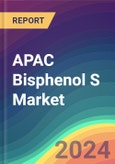Under this subscription, you would be able to access the APAC Bisphenol S market demand and supply analysis on a cloud-based platform for one year. The data is updated on a near real-time basis to add any new movement in the industry including, but not limited to new plant announcements, plant shutdowns, temporary disruptions in the demand or supply, news and deals, and much more specific to Bisphenol S.
Years Considered for Analysis:
- Historical Years: 2015 - 2019
- Base Year: 2020
- Estimated Year: 2021
- Forecast Period: 2022 - 2030
Deliverables:
- Installed Capacity By Company-Installed capacity at a regional level along with the individual capacity of leading players
- Installed Capacity By Location-Installed capacity at country level
- Installed Capacity By Process-Installed capacity by different processes
- Installed Capacity By Technology-Installed capacity by different technologies being used to produce Bisphenol S
- Production By Company-Actual production done by different companies
- Operating Efficiency Company-Operating efficiency at which different companies are operating their plants
- Demand By End Use-Demand/Sale of Bisphenol S in different end-user industries across the region
- Demand By Sales Channel-Demand/Sale of Bisphenol S by different sales channels across the region
- Demand By Country-Demand/Sale of Bisphenol S in different countries of the region China, India, Japan, South Korea, Malaysia, Taiwan, Rest of APAC
- Demand & Supply Gap-Demand & Supply Gap at the regional level
- Market Share of Leading Players-Revenue shares of leading players in the region.
- News & Deals Historical & Current News & Deals in Bisphenol S market
Please note: The subscription will be activated within 3 business days
Table of Contents
1. Asia Pacific Bisphenol S Market Outlook, 2015-20301.1. Capacity, By Volume
1.1.1. By Country
1.2. Production, By Volume
1.2.1. By Country
1.3. Operating Efficiency
1.3.1. By Country
2. Asia Pacific Bisphenol S Demand Outlook, 2015-2030, By Volume
2.1. By End use
2.2. By Country
2.3. China Bisphenol S Market Outlook, 2015-2030
2.3.1. Capacity, By Volume
2.3.1.1. By Company
2.3.1.2. By Location
2.3.2. Production, By Volume
2.3.2.1. By Company
2.3.3. Operating Efficiency
2.3.3.1. By Company
2.3.4. China Bisphenol S Demand-Supply Scenario, 2015-2030, By Volume
2.3.4.1. Demand
2.3.4.2. Supply
2.3.4.3. Gap
2.3.5. China Bisphenol S Demand Outlook, 2015-2030, By Volume
2.3.5.1. By End use
2.3.5.2. By Company Share (At least top 3 companies’ market share)
2.3.5.3. By Region
2.3.5.4. By Sales Channel
2.4. India Bisphenol S Market Outlook, 2015-2030
2.4.1. Capacity, By Volume
2.4.1.1. By Company
2.4.1.2. By Location
2.4.2. Production, By Volume
2.4.2.1. By Company
2.4.3. Operating Efficiency
2.4.3.1. By Company
2.4.4. India Bisphenol S Demand-Supply Scenario, 2015-2030, By Volume
2.4.4.1. Demand
2.4.4.2. Supply
2.4.4.3. Gap
2.4.5. India Bisphenol S Demand Outlook, 2015-2030, By Volume
2.4.5.1. By End use
2.4.5.2. By Company Share (At least top 3 companies’ market share)
2.4.5.3. By Region
2.4.5.4. By Sales Channel
2.5. Japan Bisphenol S Market Outlook, 2015-2030
2.5.1. Capacity, By Volume
2.5.1.1. By Company
2.5.1.2. By Location
2.5.2. Production, By Volume
2.5.2.1. By Company
2.5.3. Operating Efficiency
2.5.3.1. By Company
2.5.4. Japan Bisphenol S Demand-Supply Scenario, 2015-2030, By Volume
2.5.4.1. Demand
2.5.4.2. Supply
2.5.4.3. Gap
2.5.5. Japan Bisphenol S Demand Outlook, 2015-2030, By Volume
2.5.5.1. By End use
2.5.5.2. By Company Share (At least top 3 companies’ market share)
2.5.5.3. By Region
2.5.5.4. By Sales Channel
2.6. South Korea Bisphenol S Market Outlook, 2015-2030
2.6.1. Capacity, By Volume
2.6.1.1. By Company
2.6.1.2. By Location
2.6.2. Production, By Volume
2.6.2.1. By Company
2.6.3. Operating Efficiency
2.6.3.1. By Company
2.6.4. South Korea Bisphenol S Demand-Supply Scenario, 2015-2030, By Volume
2.6.4.1. Demand
2.6.4.2. Supply
2.6.4.3. Gap
2.6.5. South Korea Bisphenol S Demand Outlook, 2015-2030, By Volume
2.6.5.1. By End use
2.6.5.2. By Company Share (At least top 3 companies’ market share)
2.6.5.3. By Region
2.6.5.4. By Sales Channel
2.7. Malaysia Bisphenol S Market Outlook, 2015-2030
2.7.1. Capacity, By Volume
2.7.1.1. By Company
2.7.1.2. By Location
2.7.2. Production, By Volume
2.7.2.1. By Company
2.7.3. Operating Efficiency
2.7.3.1. By Company
2.7.4. Malaysia Bisphenol S Demand-Supply Scenario, 2015-2030, By Volume
2.7.4.1. Demand
2.7.4.2. Supply
2.7.4.3. Gap
2.7.5. Malaysia Bisphenol S Demand Outlook, 2015-2030, By Volume
2.7.5.1. By End use
2.7.5.2. By Region
2.7.5.3. By Sales Channel
2.7.5.4. By Company Share (At least top 3 companies’ market share)
2.8. Taiwan Bisphenol S Market Outlook, 2015-2030
2.8.1. Capacity, By Volume
2.8.1.1. By Company
2.8.1.2. By Location
2.8.2. Production, By Volume
2.8.2.1. By Company
2.8.3. Operating Efficiency
2.8.3.1. By Company
2.8.4. Taiwan Bisphenol S Demand-Supply Scenario, 2015-2030, By Volume
2.8.4.1. Demand
2.8.4.2. Supply
2.8.4.3. Gap
2.8.5. Taiwan Bisphenol S Demand Outlook, 2015-2030, By Volume
2.8.5.1. By End use
2.8.5.2. By Region
2.8.5.3. By Sales Channel
2.8.5.4. By Company Share (At least top 3 companies’ market share)
2.8.5.5. By Company
3.1. Country-wise Import
3.2. Country-wise Export
4. News and Deals








